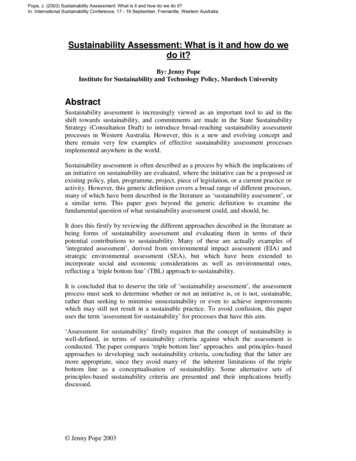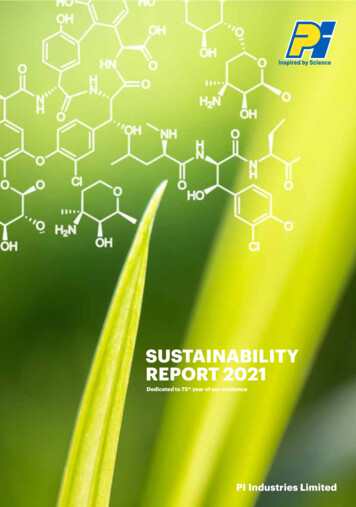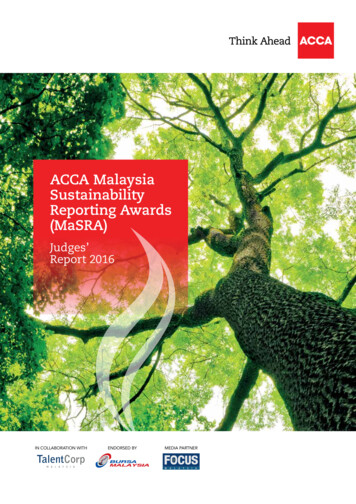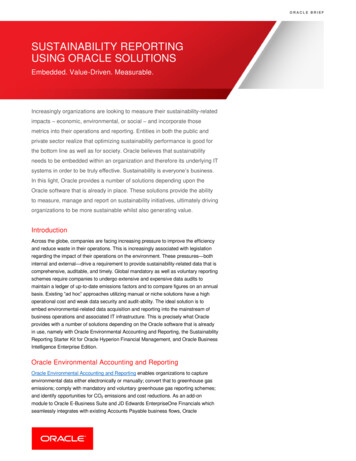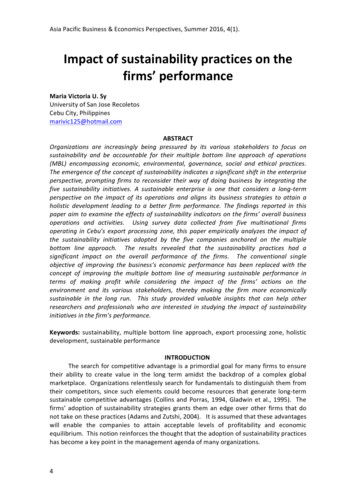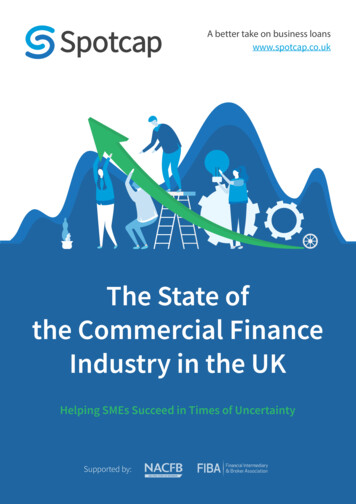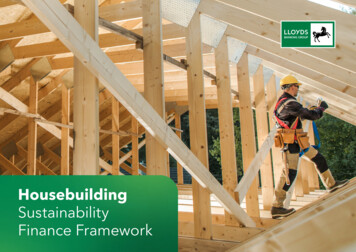
Transcription
HousebuildingSustainabilityFinance Framework
CONTENTS Housebuilding Sustainability Finance rpose of this Sustainability Financing Framework1.2About Lloyds Banking Group1.3Our Alignment to the UN Sustainable Development Goals and our ESG credentials1.4Our Sector Based Approach1.5Strategic Priority to support the Housing sector1.6Scope of Framework2Sustainability Finance FrameworkIntroduction2.2Sustainability-Linked LoansProcess for Loan Assessment and Approval2.2.1Selection of Key Performance Indicators (KPIs)Financing linked to Use of Proceeds (Green Loans)2.2.2Calibration of Sustainability Performance Targets (SPTs)2.1.1Use of Proceeds2.2.3Loan Characteristics2.1.2Process for Project Evaluation and Selection2.2.4Reporting2.1.3Management of esaNextGeneration Project Eligibility CriteriabNextGeneration Core Assessment CriteriacNextGeneration BenchmarkDisclaimer2.3External Review
Introduction2Sustainability Finance ilding Research Establishment Environmental Assessment Method is a sustainability assessment method for master planningprojects, infrastructure, and buildings. It recognises and reflects the value in higher performing assets across the built environmentlifecycle, from new construction to in-use and refurbishment.1CIBCorporate and Institutional Banking. This is one of the business units within the Group which looks after clients with a turnover of 100m or higher.CGFIThe Clean Growth Financing Initiative is the Group’s proposition to provide discounted financing for sustainability projects. In thehousebuilding sector, our smaller clients (typically SME and Mid Corporates) are eligible for CGFI, whilst larger operators will engagewith our Sustainable Development Loan proposition.Eligible GreenProjectA development project where the client meets the relevant eligibility criteria for the Business & Commercial Banking and Corporate& Institutional Banking business units. These are detailed within this document on page 22, under ‘Green Buildings’.EPCAn Energy Performance Certificate measures the energy efficiency and environmental impact of a property on a scale of A–G (A beingthe most efficient).ESGESG stands for Environmental, Social, and Governance and form a set of standards for a company’s behaviour used by sociallyconscious investors to screen potential investments. Environmental factors consider the quality and functioning of the natural environment. Social factors consider the rights, wellbeing and interests of people and communities. Governance factors consider the policies or practices by which a company is directed or controlled.GAEF1The Green Asset Eligibility Forum is a forum comprising of senior colleagues from across the Business & Commercial Banking andCorporate & Institutional Banking business units including Portfolio Analytics, Lending Products, Risk, Coverage and Sustainability& Responsible Business. This forum sets the eligibility criteria for Loan Propositions within these business units and convenes meetingsweekly to review and consider client transactions that have been escalated from either the CGFI mailbox or the RE&H GWP (definedlater in this glossary).Description as taken from the BREEAM website; more information available here: BREEAM – Sustainability Assessment MethodCONTENTS3Housebuilding Sustainability Finance Framework1GLOSSARYGlossary
2IntroductionSustainability Finance FrameworkAppendicesTermDescriptionGLPsGreen Loan Principles2 are a high-level framework of market standards and guidelines, published by the LMA together with the AsiaPacific Loan Market Association and the Loan Syndications and Trading Association and with the support of the International CapitalMarkets Association, providing a consistent methodology for use across the green loan market.Green LoansGreen Loans, referred to in this document, relate to any loan instrument made available exclusively to finance a new Eligible GreenProject, in the opinion of the Group.GroupGroup means the group of companies including Lloyds Banking Group plc and all of its direct and indirect subsidiaries. For thepurpose of this Framework, the scope covers the following business units: Business & Commercial Banking and Corporate &Institutional Banking3.HQMThe Home Quality Mark (HQM)4 is an independently assessed certification scheme for new homes. It awards certificates with a simplestar rating for the standard of a home’s design, construction, and sustainability.JLLJones Lang LaSalle performs the secretariat function for the NextGeneration Initiative.KPIsKey Performance Indicators are a measurable value that demonstrates how effectively a company is achieving key business objectives,in this context, external ratings and/or equivalent metrics which measure improvements in the borrower’s sustainability profile.LEEDLeadership in Energy and Environmental Design5 is a green building rating system. Available for virtually all building types, LEEDprovides a framework for healthy, highly efficient, and cost-saving green buildings.LMAThe Loan Market Association aims to improve liquidity, efficiency, and transparency in the primary and secondary syndicated loanmarkets in Europe, the Middle East and Africa. A s last updated in February 2021 and available here:LMA Green Loan Principles4 Description as taken from the HQM website; more information available here:Home Quality Mark – BRE Group Business Banking (which covers businesses with a turnover of 3m and below) is out ofthe scope of this Framework. 5 Description as taken from the US GBC website; more information available here:LEED rating system U.S. Green Building Council (usgbc.org)23CONTENTS4Housebuilding Sustainability Finance Framework1GLOSSARYGlossary
Glossary12IntroductionSustainability Finance FrameworkAppendicesLoan PropositionsWe offer three Loan Propositions that support the housebuilding sector with property development6 in the Business & CommercialBanking and Corporate & Institutional Banking business units:Mid CorporatesThis is a customer segment which sits within the Business & Commercial Banking business unit. It looks after clients with a turnover ofbetween 25m and 100m.NextGenerationAn organisation which has developed sustainability standards in collaboration with the construction industry relating to high-quality,sustainable homebuilding7.PassivhausThe Passivhaus Trust8 is an independent industry organisation that promotes the adoption of Passivhaus in the UK. Passivhaus adopts awhole-building approach with clear, measured targets, focused on high-quality construction, certified through an exacting qualityassurance process.Housebuilding Sustainability Finance FrameworkDescriptionRCFsRevolving Credit Facilities are a form of credit issued by a financial institution that provide the borrower with the ability to draw, repayand redraw funds again. A revolving loan is considered a flexible financing tool due to its repayment and re-borrowingaccommodations.GLOSSARYTerm5RE&H GWPThe Real Estate & Housing Green Working Party is a forum comprising of senior colleagues from across the Business & CommercialBanking and Corporate & Institutional Banking teams including Portfolio Analytics, Lending Products, ESG Finance and the Real Estate& Housing Coverage teams. This convenes meetings monthly (or ad hoc where time critical) to review and approve Green andSustainability-Linked Real Estate & Housing transactions for the real estate, housebuilding and social housing sectors.i. CGFI, as defined earlier in this glossary provides “entry level” support for housebuilders and developers.ii. Sustainable Development Loans (SDLs), as defined later in this glossary for a larger operator andiii. Sustainability-Linked Loans (SLLs), as defined later in this glossary for a larger operator. We offer an additional proposition to our Corporate and Institutional Banking clientsto finance or refinance existing buildings, which is out of the scope of this Framework.6 Description as taken from the Passivhaus Trust website, more information availablehere: What is Passivhaus?8 NextGeneration is a sustainability benchmarking system for UK housebuilders'.More information available here: nextgeneration-initiative.co.uk7CONTENTS
Introduction2Sustainability Finance FrameworkTermDescriptionSAPThe Standard Assessment Procedure9 is the methodology used by the UK Government to assess and compare the energy andenvironmental performance of dwellings. SAP was developed by the Building Research Establishment, as a tool to help deliver energyefficiency policies.SDLsSustainable Development Loans are the Group’s proposition to provide discounted financing for sustainability projects within thehousebuilding sector for larger clients.SLLsSustainability-Linked Loans are types of loan instruments which incentivise the borrower’s achievement of ambitious, predeterminedsustainability performance objectives.SLLPsSustainability-Linked Loan Principles10, published by the LMA together with the Asia Pacific Loan Market Association and the LoanSyndications and Trading Association provide a high-level framework, enabling all market participants to clearly understand thecharacteristics of a Sustainability-Linked Loan.SMEsSmall and Medium Sized Enterprises. This is a customer segment which sits within the Business & Commercial Banking business unit. Itlooks after clients with a turnover of between 3m and 25m.SPTsSustainability Performance Targets are the objectives (described in terms of KPIs) to be met by a client under an SLL.Sustainabilityand ESGFinancing teamThe Group’s Sustainability and ESG Finance Team or its successor who currently serve the Corporate and Institutional Bankingbusiness unit.TCFDThe Task Force on Climate-Related Financial Disclosures (TCFD) was created in 2015 by the Financial Stability Board (FSB) to developconsistent climate-related financial risk disclosures for use by companies, banks, and investors in providing information tostakeholders.UN SDGsThe 17 UN Sustainable Development Goals were set in 2015 as part of UN Resolution 70/1, the 2030 Agenda for SustainableDevelopment. The UN SDGs are intended to provide a blueprint to achieve a better and a more sustainable future for all. They areaimed at addressing the global challenges faced by society, including those related to poverty, inequality, climate change,environmental degradation, peace, and justice. The UN SDGs are intended to be achieved by 2030. Description as taken from the Government website; more information available here: Standard Assessment Procedure910Appendices As last updated in March 2022 here: LMA Sustainability-Linked Loan PrinciplesCONTENTS6Housebuilding Sustainability Finance Framework1GLOSSARYGlossary
SECTIONSECTION?1?IntroductionCONTENTS
2IntroductionSustainability Finance FrameworkAppendicesIntroduction1.1 Purpose of this Sustainability Finance FrameworkThe purpose of this document is to outline the supportwe offer the housebuilding sector to build new houses,from some of the smallest developers to the largesthousebuilders. This Sustainability Finance Framework(hereafter referred to as the “Framework”) sets out theunderlying eligible qualifying purposes, themes, andactivities to classify the Group’s Loan Propositions assustainable finance in the housebuilding sector.The Framework aims to establish a consistent andcomprehensive methodology for the classification andreporting of these financial products as sustainable11.This Framework outlines the sustainable financeproducts and propositions offered by the Group tosupport developers and housebuilders with propertydevelopment.There are two types of Loan Propositions:i. “Use of Proceeds” or “Green” Loans, whichsupport a client’s specific sustainable projects.This Framework lays out the next step in ourcommitment to support the creation of nationalsustainability standards for housebuilding finance that: Supports our housebuilder and developer clients’financing requirements (all lending is subject tostatus and the required product, credit and otherinternal approvals being granted). Enhances understanding and implementationof best practice of sustainability, whilst alsodeepening relationships and collaborationbetween housebuilding clients and the Groupto support the sector’s transition to net zero. Aligns to LMA principles, supporting ‘Use ofProceeds (Green Loans)’ via the GLPs12 and‘Sustainability-Linked’ Loans via the SLLPs13.DNV has been appointed to confirm the alignmentof this Framework to the LMA principles, theirSecond Party Opinion is available here.ii. “Sustainability-Linked” Loans, which align to aclient’s corporate strategy to embed sustainabilitygoals by reference to agreed SPTs. The environment within the built environment, financial services and sustainable finance is a moving landscape and as such we may review fromtime to time in the context of emerging new definitions, regulations and best practice. This is further covered in the disclaimer on page 34.111213 As published here at February 2021: LMA Green Loan Principles As last updated here in March 2022: LMA Sustainability-Linked Loan PrinciplesCONTENTSThis Framework laysout the next step in ourcommitment to supportthe creation of nationalsustainability standardsfor housebuildingfinance.8Introduction Housebuilding Sustainability Finance Framework11SECTION 1 SECTIONGlossary
12IntroductionSustainability Finance FrameworkAppendices1.2 About Lloyds Banking GroupThe Group is the UK’s largest retail and commercial financial services provider,with 26 million clients and a presence in nearly every community. We have animportant role to play in supporting the UK economy through lending,deposits, risk management and the efficient flow of funds, while working withothers to help build an inclusive, greener, and more resilient economy.Building on our strong foundations, our purpose of Helping Britain Prosperforms the basis of our new strategy to profitably deliver for all of ourstakeholders. Core to our purpose and strategy is our focus on building aninclusive society and supporting the transition to a low carbon economy.This is where we can make the biggest difference, whilst creating newavenues for our future growth. It is only by doing right by our customers,colleagues, and communities that we can achieve higher, more sustainablereturns for shareholders.SECTION 1 To ensure that our purpose is at the heart of our business, strategy, andculture, we have developed a clear and ambitious mission, which defineswhat it means to Help Britain Prosper. This mission will frame our plans,shape current and future decisions, and drive impact beyond ourbusiness-as-usual activities. It exists to guide the actions of everycolleague across the Group, every day.Core to our purposeand strategy is ourfocus on building aninclusive society andsupporting thetransition to a lowcarbon economy9Introduction Housebuilding Sustainability Finance FrameworkGlossaryFind out more about our Strategy and Purpose.Our purpose is HelpingBritain ProsperWe achieve this by creating a moresustainable and inclusive future forpeople and businesses, therebyshaping finance as a force for good.CONTENTS
2IntroductionSustainability Finance FrameworkAppendices1.3 Our Alignment to the UN Sustainable Development Goals and our ESG credentialsWith our purpose of Helping Britain Prosperfirmly in mind, the UN SDGs provide a soundframework for identifying how we can play amore active role in the sustainable developmentof UK society. They also help frame how we useour operating model, resources, and skillsets torespond to some of the societal challenges facedby the UK. The Group is focusing on the UN SDGswith the highest materiality to our business andsector, based on commercial exposure, thesphere of the Group’s impact, and those of thehighest materiality to our key stakeholders (basedon our research and insights).Some of the areas of activity guided by our purpose include, but are not limited to, action and initiativesaround the following topics in support of the achievement of specific UN SDGs:Promoting financial inclusion and educationFinancial inclusion, wellbeing and resilience ofour customers to support reduced inequalitiesInclusive and diverse businessBuilding an inclusive business and promotingcolleague and customer wellbeing, improvingaccess to decent living, to support good healthand wellbeingSDGSDGsEnabling regional development andimproving access to quality housingHelping businesses of all sizes around thecountry, and funding more inclusive anddiverse businesses, to thrive and create qualityjobs to support gender equalitySupporting the transition to a low carboneconomyClimate and green finance opportunities,emissions reduction and risk management, tosupport global and national climate actionSDGsSDGsCONTENTS10Introduction Housebuilding Sustainability Finance Framework1SECTION 1 Glossary
1Introduction2Sustainability Finance FrameworkAppendicesMemberships, Awards & AccreditationsSustainability is a global challenge that requires collaboration across companies and industries to ensure the risks andopportunities can be adequately identified and managed. To support this, we participate in several industry initiatives andhave signed up to key principles that drive action on sustainability, including:Ranked as A- by CDP forClimate Change in 2021Ranked as a leader among 189 companiesin the banks industry by the Morgan StanleyCapital International Index in 2021Net-ZeroBanking AllianceProud to have been named Business Bankof the Year for 17 consecutive years atthe FDs’ Excellence Awards We are a Gold Leaf Member of theUK Green Buildings CouncilWe joined the Executive Committee of theNextGeneration Initiative in 2021Member of the GFI’s Coalition for the EnergyEfficiency of Buildings (CEEB), developingsolutions to help decarbonise the UK’s buildingsWe have renewed our commitment to the WorldGreen Building Council Net Zero CarbonBuildings Commitment. This includes the newembodied carbon reduction requirement fornew builds and major refurbishments by 2030SECTION 1 We are a founding member of theNet Zero Banking Alliance (NZBA),which aims to accelerate the transitionto net zero emissions by 2050We have achieved Carbon TrustStandard certification for reducingboth carbon and waste11Introduction Housebuilding Sustainability Finance FrameworkGlossaryCONTENTS
2IntroductionSustainability Finance FrameworkAppendices1.4 Our Sector Based Approach1.5 Strategic Priority to support the Housing sectorClimate change is one of the most urgent issues facing society today.We believe that the transition to a low carbon economy represents anopportunity to build a resilient future, creating new businesses and jobs forthe UK. The transition will require significant transformation of every sectorat scale. We want to play our part as the UK’s largest financial servicesprovider in supporting the transition to net zero and we support the aims ofthe 2015 Paris Agreement, the UK Government’s net zero target, the TenPoint Plan for the Green Industrial Revolution, and the recommendations ofthe TCFD.Our focus on HousingWe continue to progress towards our net zero ambitions across ourbusiness lines and our own operations. We have identified our priority areasof focus, which form a fundamental part of our overall approach to net zeroand represent where we see the greatest challenge and opportunity to helpaccelerate the transition to a low carbon economy for the UK, which are: Greening the built environment Supporting the energy transition Low carbon transportation Sustainable farming and natural capital Sustainable investments and pensions40%The built environmentaccounts for around40% of CO2 emissionsin the UK15The Group is one of the largest funders14 to the UK housebuilding sector,and we understand that we have a significant role to play in helping tohouse the nation, whether that is through mortgages for customers orsupporting housebuilders and housing associations. Access to secure, highquality, sustainable homes is core to societal wellbeing and to make this areality, we’re providing long standing support for this important sector.The coronavirus pandemic has highlighted just how vital access toappropriate housing is. Furthermore, we must also make sure that homessupport the UK government’s sustainability targets and build towards agreener future. The built environment accounts for around 40% of CO2emissions in the UK15.Decarbonisation of homes, new and existing, will be essential to deliveringthe UK Net Zero target16. As a result, the UK Government is currentlyconsulting on a number of measures to address this. Most notably, theFuture Homes Standard will come into effect in England in 2025 andrequires that homes produce 75%-80% less CO2 emissions compared tocurrent building regulations.17Our strategic ambition includes supporting the building of sustainable,affordable, and high-quality housing while transitioning to a low carboneconomy. In doing so, we’ll also support improved financial health andwellbeing for households across the UK and help businesses in theconstruction industry to recover and adapt post the pandemic. Enabling access to homes in the UK – Lloyds Banking Group14 Climate Change Committee – The Sixth Carbon Budget15 Net Zero: The UK's contribution to stopping global warming (CCC)1617 The Future Homes StandardCONTENTS12Introduction Housebuilding Sustainability Finance Framework1SECTION 1 Glossary
2IntroductionSustainability Finance FrameworkAppendicesOur activity in the Housing sectorGreen Buildings ToolRegeneration BraineryTo help support a move towards sustainable buildings, our customers havefree of charge access to our Green Buildings Tool – a digital insights calculatorthat helps to identify, evaluate, and understand the estimated outcomes ofpotential investments to make properties greener. From a single propertythrough to larger portfolios, the tool helps clients analyse energy savinginitiatives that affect the EPC rating and reveals initiatives/properties that offerthe best return on investment with regards to carbon reduction.To support closing the future skills gap in UK housing, in 2021 alongsideother partners18, we announced a three-year partnership with RegenerationBrainery that encourages school leavers from socially and economicallydeprived areas into real estate, construction, and regeneration. To date, wehave supported 50 school leavers with two Braineries held in Manchesterwith more Braineries in plan across the UK in 2022.Social HousingWe also continue to drive the Housing Growth Partnership (HGP),providing financial support and mentoring to small and mid-sizedhousebuilders with over 2,500 HGP supported homes built across the UKto date, with a total pipeline of almost 5,000 homes. During 2021, HGP 2was launched to support the construction of a wider tenure of homes tomeet the diverse and evolving UK housing need. The Regional GrowthInitiative was also introduced to help small and medium-sizedhousebuilders create more homes in the North of England, the Midlands,and the regions of Scotland.In response to a lack of affordable housing, which we recognise can be apotential barrier to tackling social disadvantage, we have worked with morethan 200 housing associations across the UK. Over the last four years, wehave provided over 12 billion of funding to the social housing sector, and,to further support housing associations, we have become early adopters ofthe new Sustainability Reporting Standards. These aim to standardise ESGreporting in the social housing sector by providing housing associationswith a framework for implementation and reporting of their ESGperformance, as well as unlocking investment. We have also securedcolleague representation on the Board of Sustainability for Housing Limitedwhich is responsible for the reporting standards.Housing Growth PartnershipWe recognise the retrofitting challenge residential landlords and housingassociations face across their portfolios to reduce their environmentalimpact and generate significant economic and societal benefits. To supportthe retrofit challenge in social housing, in 2021 we provided 3.4 billion ofnew funding, of which 2.4 billion was sustainable (green or social use ofproceeds) or sustainability-linked (including ESG key performanceindicators). Additionally, in 2021, around 240,000 social housing buildingswere assessed by our Green Buildings Tool to help the sector continue itsdecarbonisation journey. This includes BDP, Capital & Centric and Homes England.18CONTENTSSupporting closingthe future skills gapin UK housingTo date, we havesupported 50 schoolleavers with twoBraineries held inManchester with moreBraineries in plan acrossthe UK in 2022.13Introduction Housebuilding Sustainability Finance Framework1SECTION 1 Glossary
Sustainability Finance FrameworkAppendicesNextGeneration Initiative In March 2021, we joined the Executive Committee ofthe NextGeneration Initiative which was established tofurther enhance the transparency and sustainabilityambitions of the housebuilding sector.The NextGeneration Initiative has been established forover 15 years and provides the leading sustainability benchmark for the UK’slargest 25 housebuilders, with over 60 different criteria across 15 focus areas19which are weighted based on their overall sustainability impact.Together all three initiatives enable operators in all segments of thehousebuilding sector to assess and improve their sustainabilityperformance and access dedicated finance to achieve this.The Group’s support of these initiatives also stems from the belief that thesestandards unlock a key obstacle to housebuilders and developers(particularly at the smaller end of the market) being able to pursue effectivesustainability objectives and report on the same.The NextGeneration Benchmark was originally developed in 2006 to buildupon the successes of previous benchmarking exercises undertaken byInsight Investment and WWF UK. The NextGeneration Benchmark wasdesigned for assessing the corporate sustainability of the largesthousebuilders in the UK, but recently the service offering has expanded tosupport all housebuilders across the UK, regardless of size to improve theirsustainability performance.The NextGeneration Initiativehas been established for overa decade and provides theleading sustainabilitybenchmark for theUK’s largestAs part of our work as a member of the NextGeneration ExecutiveCommittee, we have helped to develop:i.25 ‘NextGeneration Project’ – This is an assessment for housebuilders touse to demonstrate the sustainability of an individual development, withdistinct levels of award provided depending on the number of criteriaachieved. This is to support housebuilders to communicate theirsustainability and improve their performance.housebuilders,with over 60 differentcriteria across 15 focusareas19 which are weightedbased on their overallsustainability impact.ii. ‘NextGeneration Core’ – This is an assessment based on a core set ofsustainability criteria curated from the NextGeneration Benchmark thatis designed for assessing the corporate sustainability of mid-corporatehousebuilders and supporting them to improve their sustainabilityperformance.These two standards have been approved by the NextGeneration ExecutiveCommittee and complement the existing NextGeneration Benchmark. Detail on these focus areas can be found here: ction Housebuilding Sustainability Finance Framework2IntroductionSECTION 1 1Glossary
GlossaryIntroduction2Sustainability Finance FrameworkAppendicesScope of FrameworkIt is important to the Group that sustainable finance is accessible and available to as many operators aspossible. Within the Framework, we have intentionally taken an approach to ensure that the broaderhousebuilding sector is covered from the some of the smallest developers to the largest housebuilders,and that the resources available to each sized operator are considered when designing the relevantLoan Proposition. For this Framework, the scope covers the following business units: Business& Commercial Banking and Corporate & Institutional Banking20.The housebuilding sector generally has a material impact on UK carbon emissions. This documentoutlines the Group’s sustainable finance offering for the housebuilding sector but for completeness,the Group does also support housebuilders or developers who do not opt for a sustainable financeproduct. For these clients, all lending is subject to status and the required product, credit and otherinternal approvals, which would include meeting certain minimum ESG requirements as detailed in the‘customer monitoring and due diligence section’ of our sector statements here (albeit not as stringentas those applicable to sustainable finance products).Sustainable Loan PropositionsWe offer a range of sustainable finance propositions and tools which are constantly evolving. As at thedate of this Framework, those Loan Propositions that support the housebuilding sector for propertydevelopment (the “Loan Propositions”) are detailed below.SECTION 1 These Loan Propositions fall under two categories: Useof Proceeds (Green Loans) – These are a type of loan instrument made available exclusively tofinance, in whole or in part, new and/or existing Eligible Green Projects.i.ii. S ustainability-Linked – These are a type of loan instrument which incentivise the borrower’sachievement of ambitious, predetermined sustainability performance objectives, as detailed in theglossary.The use of proceeds in relation to a Sustainability-Linked Loan is not a determinant in its categorisationand, in most instances, Sustainability-Linked Loans will be used for ge
6 GLOSSARY Housebuilding Sustainability Finance Framework Glossary 1 Introduction 2 Sustainability Finance Framework Appendices Term Description SAP The Standard Assessment Procedure9 is the methodology used by the UK Government to assess and compare the energy and environmental performance of dwellings. SAP was developed by the Building Research Establishment, as a tool to help deliver energy
